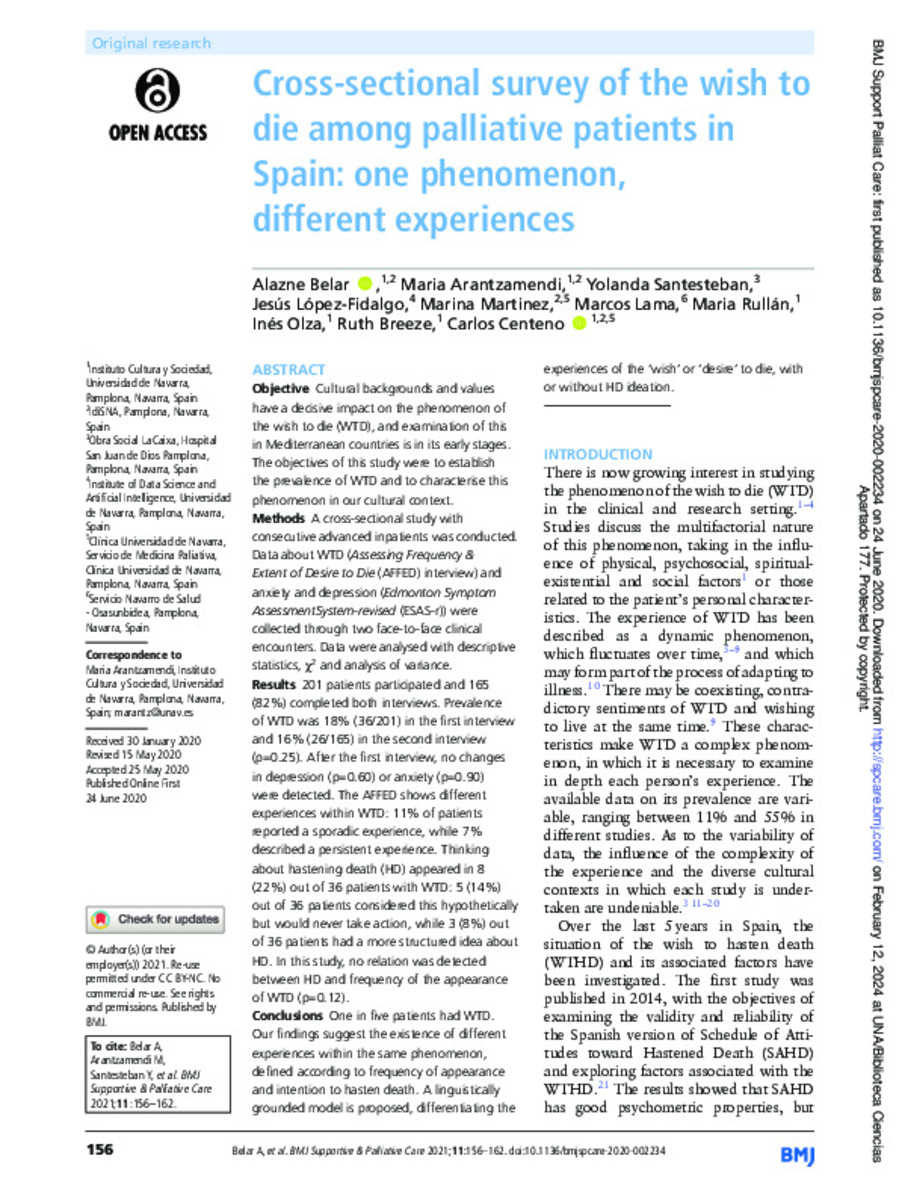Full metadata record
| DC Field | Value | Language |
|---|---|---|
| dc.creator | Martinez-Garcia, M. (Marina) | - |
| dc.creator | Belar, A. (Alazne) | - |
| dc.creator | Arantzamendi-Solabarrieta, M. (María) | - |
| dc.creator | Santesteban, Y. (Yolanda) | - |
| dc.creator | López-Fidalgo, J. (Jesús) | - |
| dc.creator | Lama, M. (Marcos) | - |
| dc.creator | Rullán, M. (María) | - |
| dc.creator | Olza-Moreno, I. (Inés) | - |
| dc.creator | Breeze, R. (Ruth) | - |
| dc.creator | Centeno, C. (Carlos) | - |
| dc.date.accessioned | 2024-02-12T13:34:52Z | - |
| dc.date.available | 2024-02-12T13:34:52Z | - |
| dc.date.issued | 2021 | - |
| dc.identifier.citation | Martinez-Garcia, M. (Marina); Belar, A. (Alazne); Arantzamendi-Solabarrieta, M. (María); et al. "Cross-sectional survey of the wish to die among palliative patients in Spain: one phenomenon, different experiences". BMJ Supportive & Palliative Care. 11 (2), 2021, 156 - 162 | es_ES |
| dc.identifier.uri | https://hdl.handle.net/10171/69083 | - |
| dc.description.abstract | Objective: Cultural backgrounds and values have a decisive impact on the phenomenon of the wish to die (WTD), and examination of this in Mediterranean countries is in its early stages. The objectives of this study were to establish the prevalence of WTD and to characterise this phenomenon in our cultural context. Methods: A cross-sectional study with consecutive advanced inpatients was conducted. Data about WTD (Assessing Frequency & Extent of Desire to Die (AFFED) interview) and anxiety and depression (Edmonton Symptom Assessment System-revised (ESAS-r)) were collected through two face-to-face clinical encounters. Data were analysed with descriptive statistics, χ2 and analysis of variance. Results: 201 patients participated and 165 (82%) completed both interviews. Prevalence of WTD was 18% (36/201) in the first interview and 16% (26/165) in the second interview (p=0.25). After the first interview, no changes in depression (p=0.60) or anxiety (p=0.90) were detected. The AFFED shows different experiences within WTD: 11% of patients reported a sporadic experience, while 7% described a persistent experience. Thinking about hastening death (HD) appeared in 8 (22%) out of 36 patients with WTD: 5 (14%) out of 36 patients considered this hypothetically but would never take action, while 3 (8%) out of 36 patients had a more structured idea about HD. In this study, no relation was detected between HD and frequency of the appearance of WTD (p=0.12). Conclusions: One in five patients had WTD. Our findings suggest the existence of different experiences within the same phenomenon, defined according to frequency of appearance and intention to hasten death. A linguistically grounded model is proposed, differentiating the experiences of the ‘wish’ or ‘desire’ to die, with or without HD ideation. | es_ES |
| dc.description.sponsorship | PI18/01703, integrated into the Plan Estatal de I+D+I 2013–2016; ISCIII-Subdirección General de Evaluación y Fomento de la investigación and the Fondo Europeo de Desarrollo Regional (FEDER) | es_ES |
| dc.language.iso | eng | es_ES |
| dc.relation | PI18/01703 | es_ES |
| dc.rights | info:eu-repo/semantics/openAccess | es_ES |
| dc.subject | Wish to die (WTD) | es_ES |
| dc.subject | Assessing Frequency & Extent of Desire to Die (AFFED) | es_ES |
| dc.subject | Edmonton Symptom Assessment System-revised (ESAS-r) | es_ES |
| dc.subject | Mediterranean countries | es_ES |
| dc.subject | Cultural backgrounds | es_ES |
| dc.title | Cross-sectional survey of the wish to die among palliative patients in Spain: one phenomenon, different experiences | es_ES |
| dc.type | info:eu-repo/semantics/article | es_ES |
| dc.relation.publisherversion | https://spcare.bmj.com/content/11/2/156 | es_ES |
| dc.editorial.note | © Author(s) (or their employer(s)) 2021. Re-use permitted under CC BY-NC | es_ES |
| dadun.citation.endingPage | 162 | es_ES |
| dadun.citation.number | 2 | es_ES |
| dadun.citation.publicationName | BMJ Supportive & Palliative Care | es_ES |
| dadun.citation.startingPage | 156 | es_ES |
| dadun.citation.volume | 11 | es_ES |
Files in This Item:
Statistics and impact
Items in Dadun are protected by copyright, with all rights reserved, unless otherwise indicated.






